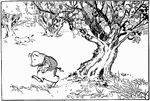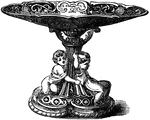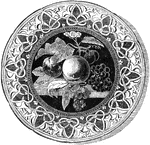Wheat
Wheat (Triticum spelta) is an annual herbaceous plant. The seed is oblong, or a compressed oval, surrounded…

Red Clover
Red Clover (Trifolium pratense) is a species of clover. The Red Clover can readily be distinguished…

Lucerne or Alfalfa Plant
Alfalfa or Lucerne (Medicago sativa) is a flowering plant in the pea family Fabaceae cultivated as an…

Lucerne or Alfalfa Plant
Alfalfa or Lucerne (Medicago sativa) is a flowering plant in the pea family Fabaceae cultivated as an…
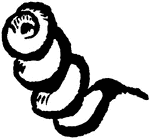
Lucerne or Alfalfa Plant
Alfalfa or Lucerne (Medicago sativa) is a flowering plant in the pea family Fabaceae cultivated as an…

Sainfoin
Sainfion (Hedysarum onobrychis), a hay, is a leguminous plant with many straggling, tapering, smooth,…
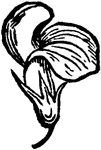
Sainfoin
Sainfion (Hedysarum onobrychis), a hay, is a leguminous plant with many straggling, tapering, smooth,…

Sainfoin
Sainfion (Hedysarum onobrychis), a hay, is a leguminous plant with many straggling, tapering, smooth,…
Threadworm
Threadworm (Nematodes) or Roundworm is composed of many different species. In all the body is slender…
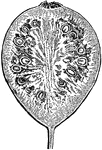
Apple Guava
Section of the fruit of the Apple Guava (Psidium guayava), a small tree in the Myrtaceae family.
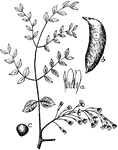
Kentucky Coffeetree
The Kentucky Coffeetree (Gymnocladus dioicus) is a tree in the Fabaceae family of legumes. It was also…

Side-Board
This side-board is made out of mahogany, traditionally used in the dining room for serving food. It…

Statuette
The statuette is a small statue that is small enough to be picked up by hand. This statuette depicts…

Fruit Dish
This fruit dish is designed with a pedestal. The base depicts the British game of cricket.

Centerpiece
This centerpiece is made with eight candlesticks in a 15th century style. It includes winged figures,…
Frieze
The frieze is a long stretch of a sculpted decoration that is typically found under crown moldings or…
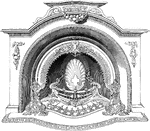
Fireplace
This fireplace is decorated with foliage and fruit. It is used to heat a room and for decorative purposes.
Vase
This vase is made of parian a form of unglazed porcelain. It is designed in high relief of flowers and…

Cabinet
This cabinet is a British design that is elaborately designed with foliage and fruit. It is used to…

Console Table with Mirror
This console table with mirror is decorated with elaborate fruit, leaves and flowers. It is used for…
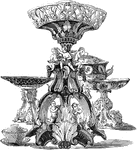
Fruit Dishes
These fruit dishes are designed in the "Louis Quatorze" style, which was during the rule of Louis XIV…
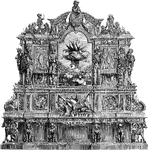
Sideboard
This sideboard is carved in walnut wood in a French Renaissance style. It is richly decorated with human…

Large Cabinet
This large cabinet is engraved in ebony and pear tree wood. Its design is elaborate with carved figures…

Aberia Caffra
"Aberia Caffra, Hook. f. & Harv. Fig. 59. Thorny, glabrous: lvs. obovate, obtuse, cuneate at base, entire:fls.…
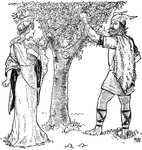
Loki Shows Idun a Crabapple Tree
Idun, the Norse goddess of youth carries a box of golden apples. Whoever eats the apples never grow…
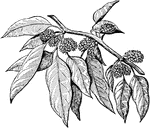
Male Flowers of the Osage-Orange
An illustration of a branch from an osage-orange plant with male flowers. Osage-orange, Horse-apple…
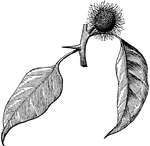
Female Inflorescence of the Osage-Orange
An illustration of a branch from an osage-orange plant with female inflorescence. Osage-orange, Horse-apple…

Male Flower of Osage-Orange
An illustration of a male flower of the osage-orange plant. Osage-orange, Horse-apple or Bois D'Arc…
Female Flower of Osage-Orange
An illustration of a female flower of the osage-orange plant. Osage-orange, Horse-apple or Bois D'Arc…

Female Flower of Osage-Orange Laid Open
An illustration of a female flower of the osage-orange plant laid open. Osage-orange, Horse-apple or…

Leaf of Osage-Orange
An illustration of a leaf of the osage-orange plant showing nervation. Osage-orange, Horse-apple or…

West Indian Mahogany Branch & Flower
An illustration of a mahogany branch, flower (a), and fruit (b).

Canada Mayflower
An illustration of flowering plant of the Canadian mayflower, flower (a), and fruit (b). Maianthemum…
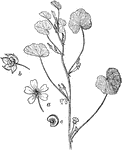
Mallow Branch
An illustration of a mallow branch with flower (a), fruit (b), and one of the carpels (C). Malvaceae,…

Manchineel Tree Stem & Fruit
An illustration of a manchineel tree stem and fruit. The Manchineel tree (Hippomane mancinella) is a…
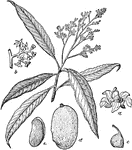
Flowering Branch of a Mango Tree
An illustration of a flowering branch of a mango tree; a, flower; b, part of inflorescence; c, pistil;…
Common Mare's Tail
An illustration of a flowering branch of common mare's tail; a, flower before athesis; b, flower after…
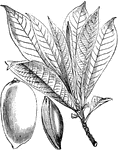
Mamey Sapote Branch & Fruit
The mamey sapote (Pouteria sapota) is a species of tree that is native to southern Mexico. Today, the…
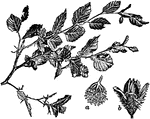
Common Beech
"Branch of Common Beech. a.-- flower; b.-- fruit. Beech, the common name of trees well known in various…

Common Beet
"Common Beet. Beet, a genus of plants, nat. order Chenopodiaceae, distinguished by its fruit being enclosed…
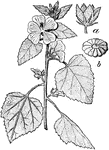
Marshmallow
An illustration of the common marshmallow, flower (a), and fruit (b). Althaea officinalis (Marshmallow,…
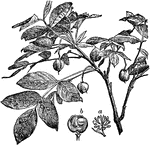
Bladdernut
"Bladder-nut. a.-- Flower. b.-- Fruit. Bladder-nut, a name of shrubs or small trees, natives of Europe,…
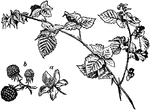
Common Bramble
"Branch of Common Bramble. a.-- Flower; b.-- Fruit. Bramble, the name commonly applied to the bush with…

Common Broom
"Branch of Common Broom. a.-- Flowering Branch. Broom, a peculiar name which includes several allied…
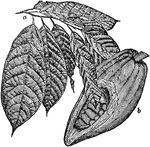
Cacao Fruit and Leaves
"Cocoa. a.-- branch with leaves; b.-- fruit (partly in section). Cacao (or Cocoa), the chocolate tree…
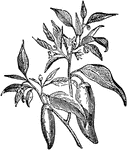
Capsicum
"Capsicum, a genus of annual, sub-shrubby plants, with a wheel-shaped corolla, projecting and converging…
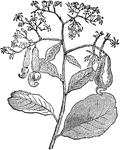
Cashew Branch
"Cashew Nut. Cashew, a tree common in the West Indies. Its fruit is called the cashew nut. The nut is…
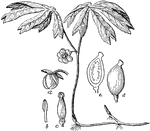
Mayapple
An illustration of a Mayapple plant. "a, the flower-bud with the bractlets; b, a stamen; c, the pistil;…

Indian Cucumber-root
An illustration showing both the flower (a) and fruit (b) of the Indian Cucumber-root plant. Medeola…
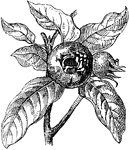
Leaves and Fruit of Common Medlar
The Common Medlar (Mespilus germanica) is a large shrub or small tree, and the name of the fruit of…
